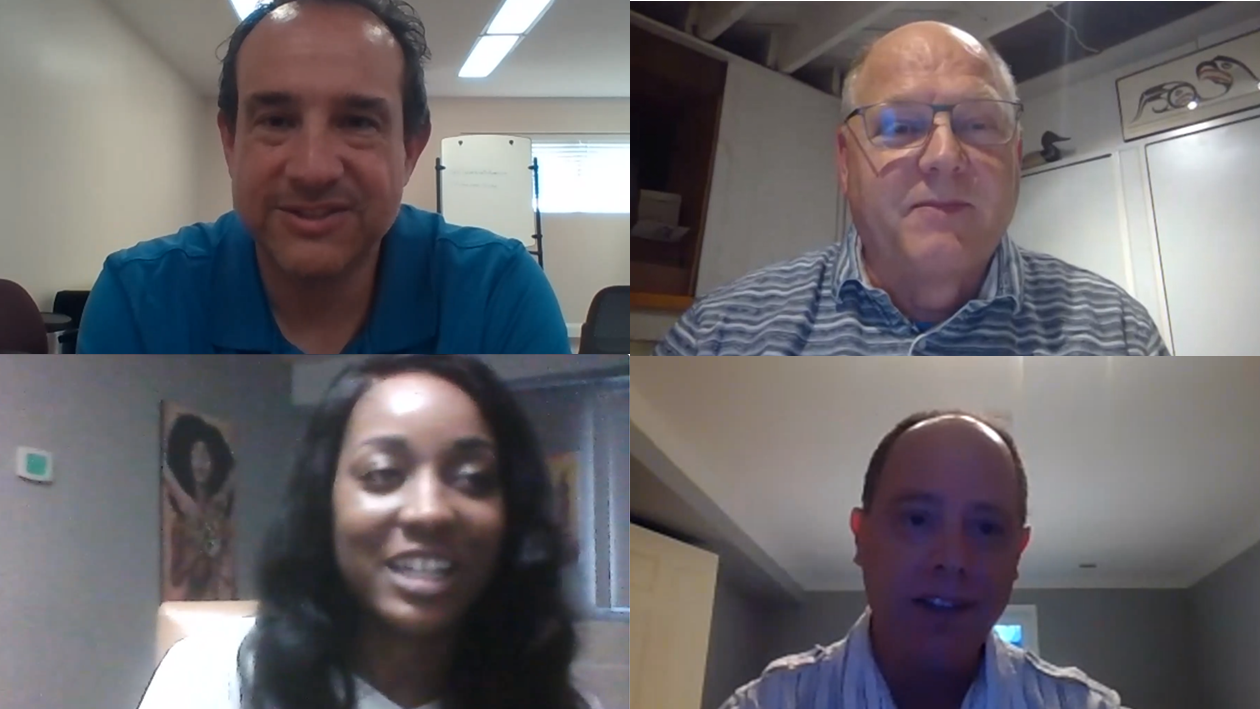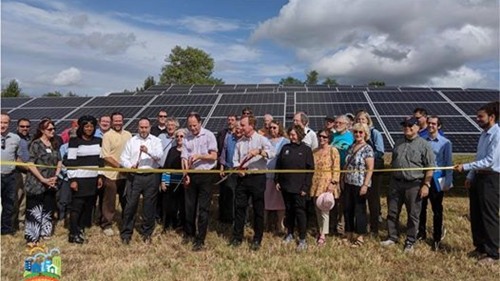By Bill Hassel

Upper left to right: Brett Marcus, John Finnerty; lower left to right: Kristal Hansley, Gary Skulnik
The power of the sun belongs to everyone, not just a privileged few. Many communities in Maryland will fall behind if steps are not taken to address the educational and outreach gaps that are preventing low and moderate-income households from participating in the growing solar industry. However, by working together, we can advance towards a brighter and more sustainable future.
The Maryland Sierra Club hosted a virtual discussion and Q&A about community solar on Wednesday, July 8 entitled "Solar Helps Advance Resident Equality (SHARE),” with guest speakers: Kristal Hansley of We Solar; Gary Skulnik of Neighborhood Sun; Brett Marcus of Solar With No Panels; and John Finnerty of Standard Solar.
Unfortunately, almost 80% of Americans do not have access to the cost savings from traditional rooftop solar as many customers are likely ineligible for rooftop solar due to low credit scores, roof shading, or they rent rather than own the property. Nearly one-third of US households also struggle to pay their utility bills, according to a 2018 US Energy Information Administration report. To make up for the hefty cost of electricity, roughly 20% of households forgo other necessities like food and medicine. Low-income communities of color are hit the hardest - spending a larger share of their income to power homes and apartments that are often older and poorly insulated.
Kristal Hansley kicked off the discussion by explaining why black and brown communities bear a disproportionate amount of the burden of pollution and suffer the worst impacts of climate change, and how community solar is addressing this by bringing renewable energy to marginalized communities.
Kristal noted that community solar is not only amazingly easy to participate in but supports both going green and building a community. Community solar has the potential to be an industry disruptor because it creates more options than traditional solar. Homeowners and renters don't have to worry about panels on their rooftops or their credit scores. As Most Americans don't have access to rooftop solar, this is one impactful way to fight climate change while also fighting disproportionate economic practices.
Black and brown communities bear a disproportionate amount of the burden of pollution and suffer the worst impacts of climate change. Community solar is addressing this by bringing renewable energy to marginalized communities.
- Kristal Hansley, We Solar
Next up was Gary Skulnik who talked about how sustainable businesses must be dedicated to their customers by forging customer engagement and happiness. The State of Maryland created provisions for subscriber organizations whose role is to educate the community about solar and facilitate enrollment. That is exactly why Neighborhood Sun created a customer advocacy board from members of the community that they meet with regularly. Neighborhood Sun also serves to help manage the project once it's up and running.

Gary provided highlights of some notable completed projects:
- The Panorama Landfill project is the largest privately-owned residential community solar project in the country with 6.6 MW and over 1,100 customers in Prince Georges county.
- The Oxon Hill project was the first community solar in Pepco territory and is on a rooftop with 0.5 MW and over 160 customers.
- The Dogwood project in Baltimore county has 4 MW and over 600 customers. During construction, invasive plants and trees were removed and replaced with indigenous species around the solar farm in BGE territory.
A few projects that are still accepting subscribers:
- In the Potomac Edison area, the Shepherds Mill solar community project is 90% filled up
- The Flintstone, Maryland solar community project, also in Potomac Edison territory
- The Henryton solar community project in BGE territory offers a 25% discount for low to moderate-income households.
Brett Marcus who spoke next, pointed out that everyone is aware renewable energy is good for the environment. Even so, most people don't want to pay a premium for renewable energy, and many low to moderate-income households are not able to pay more. Community solar offers consumers an opportunity to get all the environmental advantages of solar energy, with no cost to enroll, no panels to install on their property, no cost to leave, and no need to switch from their current energy supplier. And the upside - there is virtually no risk to the consumer, any homeowner or renter can participate, and at a discount to what they are currently paying.
Sustainable businesses must be dedicated to their customers, it is especially important to have customer engagement and happiness.
- Gary Skulnik, Neighborhood Sun
Lastly, John Finnerty talked about how fortunate Maryland is to have the Maryland Energy Administration (MEA) and the Public Service Commission (PSC) who are deeply involved in creating the policies for community solar. They make sure all the rules are in place to allow these projects to be successful for ratepayers and subscribers. Both MEA and PSC work closely with the utilities across the state to guarantee they are engaged throughout the process, including Potomac Edison, BGE, Pepco, and Delmarva.
Several questions were raised during the discussion, inluding one about the State of Maryland pollinator program and one about whether community solar would incorporate agrivoltaics in their design. As it turns out, both are being positively addressed and will support the community solar program. To learn more about the pollinator program, here is a link to the Maryland Department of State Solar Generation Facilities Pollinator-Friendly Designation. More information on the benefits of solar photovoltaic infrastructure co-located with crops ("agrivoltaics"), can be found in this article co-authored by University of Maryland researchers.
Maryland is fortunate to have the Maryland Energy Administration (MEA) and the Public Service Commission (PSC) that are deeply involved in creating the policies for community solar.
- John Finnerty, Standard Solar
Another question was asked about State-level legislation in place to create and grow solar community projects. In 2016, Maryland passed community solar legislation with the help of the Sierra Club and many others, paving the way for a three year pilot program. Since then, Maryland has passed additional legislation to extend community solar another four years. Many are still advocating for further changes and PSC is looking at extending the program while making the utilities more responsive to the needs of subscribers and subscriber organizations,
As the event came to a close, Kristal reminded everyone of the need to advocate for community solar in their own municipality and county. "Urge the local governments to adopt a community solar package and get it out there. The state law is pretty strong, and the benefits are pretty great, but most people don't know about it, so thank you to the Sierra Club for hosting this event."
Watch the full webinar here:
Speaker Bios:
Kristal Hansley, the founder and CEO of We Solar http://wesolar.energy/ brings affordable and accessible community solar energy to under-resourced communities in MD and assists commercial properties with energy efficiency. Before founding We Solar, Kristal was the Director of Government and Community Relations for Neighborhood Sun, a leading Community solar energy enterprise in Maryland. In this role, Kristal helped thousands of low-to-moderate-income families save hundreds annually on their electricity bills.
Gary Skulnik, the founder and CEOP of Neighborhood Sun http://neighborhoodsun.solar/ is a longtime climate and clean energy activist in Maryland. He previously founded and ran Clean Currents, and worked at the Sierra Club, Greenpeace, as well as the Chesapeake Climate Action Network.
Brett Marcus of Solar With No Panels http://solarwithnopanels.com/ has been in the energy efficiency industry for 11 years and helped over 16,000 residential and commercial customers switch to green energy options, and is the co-founder of Solar With No Panels.
John Finnerty is the Business Development Director for Standard Solar http://standardsolar.com/ and is focused on developing and implementing innovative renewable-energy projects. At Standard Solar, John focuses on growing local-generation markets where he organizes expert engineering, construction, finance, and operations teams to deliver solar and emerging storage projects. John is on the board of MDV-SEIA, where he continues his important advocacy on behalf of the solar industry in in Maryland, Washington, D.C., Virginia, and Delaware.